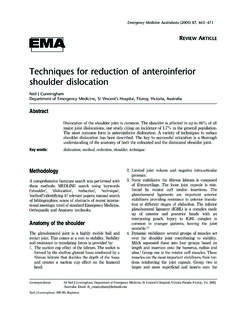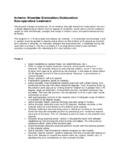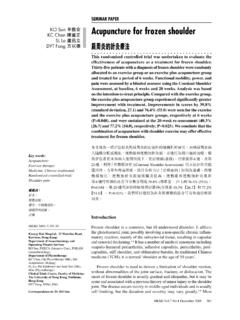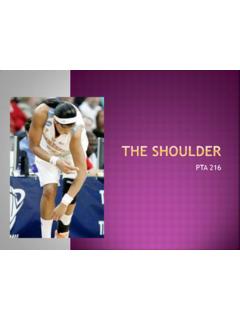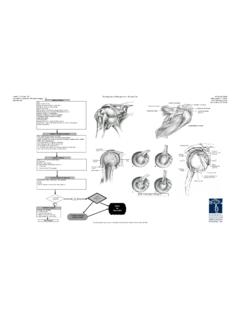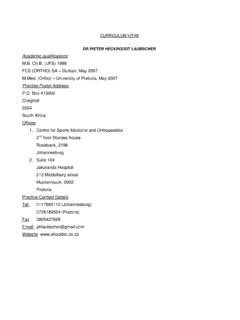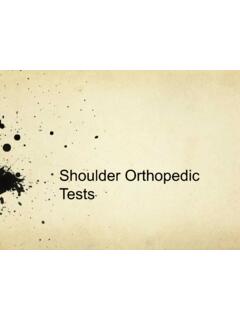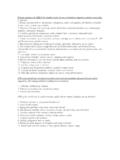Transcription of Subscapularis insufficiency and the risk of shoulder ...
1 J shoulder Elbow Surg (2009) 18, 892-896. Subscapularis insufficiency and the risk of shoulder dislocation after reverse shoulder arthroplasty T. Bradley Edwards, MD*, Matthew D. Williams, MD, Joanne E. Labriola, MD, Hussein A. Elkousy, MD, Gary M. Gartsman, MD, Daniel P. O'Connor, PhD. Fondren Orthopedic Group, Houston, TX. Hypothesis: dislocation is the most common serious complication after reverse shoulder arthroplasty . One theorized cause is Subscapularis insufficiency because the tendon cannot be repaired at the time of surgery. There are no documented risk assessments of reverse total shoulder arthroplasty dislocation related to this cause. The study objective was to quantify the risk of postoperative dislocation after reverse total shoulder arthroplasty in patients with a Subscapularis tendon that was irreparable at the time of surgery.
2 Method: A prospective evaluation was done of 138 consecutive reverse arthroplasties performed through a deltopectoral approach by a single surgeon (average follow-up, 36 months). Results: The Subscapularis was reparable in 62 patients and irreparable in 76 at the conclusion of the procedure. Seven postoperative dislocations occurred; all dislocations were in patients whose Subscapularis was irreparable (P .012). Dislocations were more likely in patients with complex diagnoses, including proximal humeral nonunion, fixed glenohumeral dislocation , and failed prior arthroplasty . Conclusions: This report documents that an irreparable Subscapularis tendon at the time of reverse total shoulder arthroplasty using a deltopectoral approach results in a statistically significant risk for postoper- ative dislocation .
3 Level of Evidence: Level IV, Case Series, Treatment Study 2009 Journal of shoulder and Elbow Surgery Board of Trustees. Keywords: Subscapularis ; irreparable; reverse; shoulder ; arthroplasty ; complication; instability; dislocation Paul Grammont8 first reported his modern design for tempered by the higher complication rate of reverse a reverse shoulder prosthesis in 1987. The reverse shoulder shoulder arthroplasty compared with unconstrained was initially designed for end-stage rotator cuff arthropathy shoulder arthroplasty . Studies of reverse total shoulder and pseudoparalysis with inability to elevate the arm. The arthroplasty (TSA) that included more than 30 patients have development and improvement of Grammont's original reported overall complication rates of 10% to 47%, with design has led to the reverse shoulder prosthesis becoming dislocation rates of 0% to 9%.
4 3,5,6,9,10,14-17 In these studies, an important tool in the treatment of difficult shoulder dislocations accounted for up to 44% of all complications. ,5,13-15 The exciting treatment possibilities and Causes of reverse TSA dislocation are often discussed results offered by the reverse prosthesis has led to an and include the number of prior procedures, surgical explosion of its use. However, the excitement must be approach, bone deficiency, Subscapularis insufficiency , mechanical factors, and trauma. The literature contains no risk assessments of reverse TSA dislocation based on *Reprint requests: Dr T. Bradley Edwards, 7401 S Main St, Houston, TX 77030-4509. known possible causes. Many patients requiring reverse E-mail address: ( Edwards).
5 TSA do not have a sufficient Subscapularis tendon to repair 1058-2746/2009/$ - see front matter 2009 Journal of shoulder and Elbow Surgery Board of Trustees. Subscapularis insufficiency and shoulder dislocation 893. because of a chronic tear with retraction and fatty infiltra- Table I Fatty infiltration of the rotator cuff musculature tion or loss of the lesser tuberosity. Boulahia et al2 stated that repair of the Subscapularis did not affect the functional Rotator cuff muscle outcome in reverse TSA patients operated on for cuff tear Fatty Supraspinatus Infraspinatus Subscapularis arthropathy. Wall et al16 also reported no effect of sub- infiltration grade scapularis repair on postoperative complications in their 0, No. (%) 11 ( ) 11 ( ) 26 ( ).
6 Series. The objective of this study is to definitively quantify 1, No. (%) 13 ( ) 12 ( ) 32 ( ). the risk of postoperative dislocation after reverse TSA in 2, No. (%) 15 ( ) 15 ( 26 ( ). patients with an irreparable Subscapularis tendon. 3, No. (%) 13 ( ) 13 ( ) 16 ( ). 4, No. (%) 86 ( ) 87 ( ) 38 ( ). Materials and methods of the 32 patients undergoing revision arthroplasty , the bone was Study group lost intraoperatively during removal of the primary prosthesis. In the other instances of bone loss, the bone loss was evident This study prospectively evaluated 138 consecutive reverse TSAs preoperatively in patients with malunion/nonunion (15 of 20), performed through a deltopectoral approach by a single surgeon postinfectious arthropathy (2 of 3), rheumatoid arthritis (1 of 5), between July 2004 and December 2006.)
7 Of these, 44 shoulders and cuff tear arthropathy (1 of 61). belonged to men (32%), and 94 belonged to women (68%), and their average age was years and years, respectively. The dominant shoulder was the operative side 57% of the time. Operative technique Average follow-up was 36 months (range, 21-56 months). Patients undergoing reverse TSA in the treatment of an acute The Aequalis reverse total shoulder system (Tornier Inc, Eden proximal humeral fracture were not included in this study group. Prairie, MN) was used in all patients. In all patients the reverse The diagnoses of patients that were included were rotator cuff prosthesis was implanted through the deltopectoral approach. The arthropathy ( ), revision arthroplasty ( ), proximal coracoacromial ligament and superior 1 cm of the pectoralis major humeral malunion or nonunion ( ), massive rotator cuff tear were released in all patients.
8 A tenodesis or tenotomy of the long with pseudoparalysis and no arthritis ( ), fixed shoulder head of the biceps tendon was also routine. The Subscapularis , if dislocation ( ), rheumatoid arthritis with massive rotator cuff intact at the time of surgery, was released using a transtendinous tear ( ), and postinfectious arthropathy with massive rotator tenotomy and was circumferentially released to increase post- cuff tear ( ). operative external rotation and facilitate repair. Preparation of the glenoid included reaming an inferior tilt of Patient evaluation 10 , and a 36-mm glenosphere was used universally. The humeral implant was cemented in 10 of retroversion in all patients. The condition of the rotator cuff was evaluated by preoperative Deltoid tension was assessed with the patient under complete magnetic resonance imaging (MRI) or computed tomographic neuromuscular paralysis.
9 Humeral component length was arthography. Advanced preoperative imaging is routine in our increased using incrementally sized polyethylene spacers until practice. The preoperative rotator cuff integrity, muscle quality, and axial motion between the glenosphere and the humeral component grade of fatty infiltration and atrophy are important in discussions of was less than 2 mm with longitudinal traction. postoperative expectations and outcomes. Detailed preoperative The status of the Subscapularis tendon and whether or not it planning may be required in cases of large glenoid cysts or glenoid was repairable was assessed and recorded at the time of surgery. bone defects not appreciated on plain x-ray films. These bone When repair was possible, a combined transosseous and trans- defects, if not considered before surgery, could have an adverse effect tendinous Subscapularis repair was completed using high-tensile- on seating of the glenoid component.
10 Isolated supraspinatus or strength nonabsorbable No. 2 suture. Repair of the Subscapularis Subscapularis tears were found in 27 patients (20%). Combination tenotomy was successful in 62 shoulders ( ) as part of the rotator cuff tears were found in 80%, with supraspinatus and infra- procedure, but 76 ( ) had an insufficient Subscapularis that spinatus tears in , Subscapularis and supraspinatus tears in was not amenable to repair (Table II). , 3-tendon tears in , and 4-tendon disruptions in A closed suction drain was placed at the time of wound closure The presence and grade of fatty infiltration in the rotator cuff and removed the day after surgery in all cases to decrease musculature was documented for each patient using the classifi- hematoma formation.



